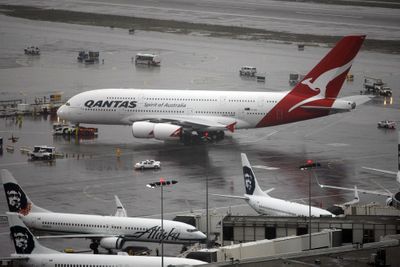Airbus giant gets special handling at landing

LOS ANGELES – Every time Qantas lands one of its giant Airbus A380s at Los Angeles International Airport, parts of the nation’s fourth-busiest airport come to a halt.
Service roads, taxiways and runways must be closed to airfield trucks, cars and other commercial aircraft as the world’s largest passenger plane – with wings almost as long as a football field – arrives, departs and taxis with an official escort of operations vehicles.
The plane is so immense that air traffic controllers give it priority so it doesn’t have to wait for takeoff at the end of the airport’s southern runways in cloudy or foggy weather because it can disrupt radio signals from the airport’s instrument landing system.
More than any other airliner, officials say, the A380 requires special procedures because the airport was not built to accommodate a plane of its size.
Federal Aviation Administration officials say that A380 operations have gone fairly well since October, when Qantas began service to Los Angeles from Melbourne and Sydney.
But air traffic controllers and airport officials caution that as airlines put more A380s into service, they could hamper airport operations and delay other commercial flights if improvements to runways, taxiways and terminals are not made in the next few years. Based on Air Transport Association figures, every minute of delay for an airliner carrying 150 people costs the carrier and passengers an average total of $152, including the value of fuel, crew time, lost productivity and other expenses.
Air traffic controllers say the current procedures work because A380s have priority, there are only one or two planes a day and the airport isn’t as busy as it once was. Since 2000, the average number of daily takeoffs and landings has dropped from about 2,150 to 1,500 because of declines in air travel after 9/11, high aviation fuel prices last summer and the nation’s sagging economy.
“The whole process is cumbersome and will cause problems down the road,” said air traffic controller Mike Foote, a local representative of the National Air Traffic Controllers Association. “If we go back to pre-recession operations levels, the situation would be untenable. There would be gridlock.”
Controllers say the potential for delay could increase dramatically with the addition of four or five A380 flights a day.
Airbus officials disagree. Years were spent developing adequate procedures, they say, and operational improvements have occurred as airports have become accustomed to the airplane. If runways, taxiways and service roads have to be closed, it is only for “a very short time,” said Dan Cohen-Nir, program manager for Airbus North America Holdings Inc.
The A380 is a big plane – a destination in itself, Lindeman says. The wingspan is about 262 feet, and the tail is 80 feet tall. The maximum takeoff weight is 1.2 million pounds. The double-deck design can carry 450 to 853 passengers and 50 percent more cargo than most other commercial aircraft.
In contrast, a Boeing 747-400 can seat 416 to 660 people. The wingspan is 211 feet, and the tail is 64 feet high. The maximum takeoff weight is about 875,000 pounds. Next to the bulky Airbus, the 747 looks streamlined.
So far, about a dozen airports in North America have had an interest in the A380, but only two have accepted the plane – John F. Kennedy International in New York and Los Angeles. San Francisco International Airport is preparing to begin A380 operations.
About $100 million has been spent at Los Angeles to accommodate the next generation of large aircraft, including the A380, Boeing 787 Dreamliner and the 747-8. About $50 million has been spent for taxiway improvements and another $50 million for two A380 gates.